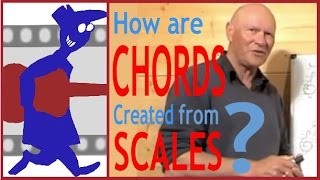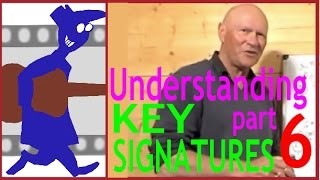Understanding Key Signatures Part 4
Published on 26 January 2016
For more information from the source site of this video please visit: http://secretguitarteacher.com/youtube/advanced/theory/jStOQ1yHPNU/84145578-understanding-key-signatures-4.php
In these two lessons we are going to completely wrap up the subject of circles of fourths and fifths as they relate to key signatures and key relationships.
Firstly, we are going to discuss a couple of points that are actually quite rarely covered in online guitar lessons and that I think you will find genuinely interesting.
Secondly, we are going to put you in a position of understanding this subject so thoroughly that you won't ever be thrown, when you come to need this knowledge to make sense of later lessons on the theory course. In particular the all-important, lessons on harmonising the major scale. You will struggle with those lessons if you haven't got a really good grasp of what we are going to wrap up in these two lessons.
Here we have a popular way of representing the sharp key signatures starting with the key of C major at the top.
This is our neutral key in the sense that it has neither sharps nor flats. Then we work round clockwise, going up the C scale FIVE notes ('cause this is the circle of FIFTHS) to the key of G which has one sharp, then on to the fifth note in the key of G - D. The key of D major has two sharps -- Then A with three sharps, E with four, B with five. F#, the fifth note in the key of B major is the next one in the circle with six sharps in the key signature and finally the key of C# major with all seven notes in the scale sharped.
Notice that, in blue writing, we have also included the relative minor keys -- these are keys that share their key signatures with the major key in the same segment of the circle. These need to become familiar to you, as there are many useful applications of knowledge involving relative keys and quite often, familiarity with these provides you with a great shortcut so -- this is good stuff for lazy people, who'd rather spend less time studying and more time playing music!
Now what I mainly want to point out to you about this diagram is what we might call the elephant in the room! We have been talking on and on about the CIRCLE of fifths, but quite clearly it's not a circle ...not a complete one anyway...at least... not yet...!
Well the next thing we are going to do is put that right!
Here's our Key signature for C# Major
We'll keep the Key signature for C# Major for now Father Charles Goes Down And Enters Battle - Seven sharps
Here's the scale notes from G#
G# A# B# C# D# E# F# G#
Now we'll use the process we used right back at the start of the first lesson we did on this -- we'll check the intervals between these notes against the MAJOR SCALE formula.. T T S T T S T What we need is TTSTTTS so where does it go wrong?
No great surprise -- it goes wrong at note SEVEN just like it always does in the circle of fifths...
But here's the great question...how can we fix it?
The answer is that we take note seven which is F# and add another sharp to it. This makes it F double sharp...
F## And we do the same in the key signature at the start of the line
Now you can be forgiven if you didn't guess that answer! Unless you have previously studied music theory to quite an advanced level, the chances are you will never have encountered double sharps.
They almost never appear in written music, but I want to stress that they come in quite handy when you are working in music theory land.
Now what does F## sound like? The answer is exactly like the note G. When you sharp a note you raise it a half step or a semitone. So if you do that to F twice you make it sound exactly like G. But why can't we simply call it G?
Because we are in the key of G# major. So every G note gets played as a G#. So we use this trick of double sharping the F and that solves the problem, I think, surprisingly neatly!So the key of G# major has eight sharps...
OK let's move on. (Continued in next Part)
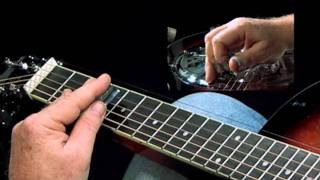 Dobro Lessons - How to Find Minor Chords - Dobro H...
Dobro Lessons - How to Find Minor Chords - Dobro H...
 MUSIC THEORY: The Harmonic Minor Scale
MUSIC THEORY: The Harmonic Minor Scale
 Pentatonic Scales On Guitar
Pentatonic Scales On Guitar
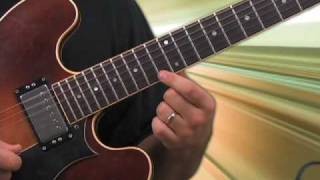 Guitar Scales Lesson - Minor Pentatonic Scale Root...
Guitar Scales Lesson - Minor Pentatonic Scale Root...
 Guitar Strumming Secrets - Part 1
Guitar Strumming Secrets - Part 1
 Mother of All Major Scale Exercises - Part 3 of 4
Mother of All Major Scale Exercises - Part 3 of 4
 Mastering Major and Minor Pentatonic Scales
Mastering Major and Minor Pentatonic Scales
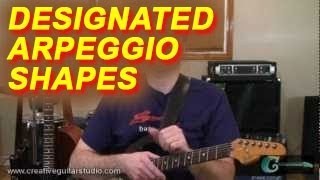 GUITAR THEORY: Designated Arpeggio Shapes
GUITAR THEORY: Designated Arpeggio Shapes
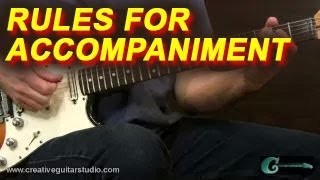 EAR TRAINING: The Golden Rules of Accompaniment
EAR TRAINING: The Golden Rules of Accompaniment
 A Beautiful Muse Chord Progression
A Beautiful Muse Chord Progression

